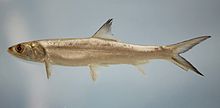The ladyfish or tenpounder (Elops saurus) is a species of fish in the genus Elops, the only genus in the monotypic family Elopidae.
| Elops saurus | |
|---|---|

| |
| Scientific classification | |
| Domain: | Eukaryota |
| Kingdom: | Animalia |
| Phylum: | Chordata |
| Class: | Actinopterygii |
| Order: | Elopiformes |
| Family: | Elopidae |
| Genus: | Elops |
| Species: | E. saurus
|
| Binomial name | |
| Elops saurus Linnaeus, 1766
| |
| Synonyms[2][3] | |
| |
Description
editLike other species in its genus, the ladyfish has a long, slender, rounded body covered with silvery scales. Its mouth is terminal and the tail is deeply forked. The species can be distinguished by counting the number of gill rakers and vertebrae.[4]
Distribution
editThe ladyfish is distributed in the western North Atlantic Ocean from New England to Florida, and the Gulf of Mexico.[4] Its distribution overlaps with the malacho (Elops smithi) in the southeast US and the southern Gulf of Mexico.[5]
Biology
editLike other members of the Elopidae, the ladyfish is a pelagic fish that spawns in the sea, but little is known about this marine phase. The larvae, which are transparent and laterally compressed, are dispersed inshore and enter embayments, where they live for 2 to 3 yr.[5][6] The juveniles are euryhaline, or tolerant to a wide range of salinity, so these embayments may be low-salinity estuaries or hypersaline lagoons.[7] Subadults move into the lower reaches of the embayments, and upon maturation, proceed to offshore, marine habitats.
Threats
editThis species uses estuarine areas and hypersaline lagoons; changes in the quality of these habitats may affect this species' population dynamics. Although this species may not be closely associated with any single habitat, it may be adversely affected by development and urbanization.[8]
References
edit- ^ Adams, A.; Guindon, K.; Horodysky, A.; MacDonald, T.; McBride, R.; Shenker, J.; Ward, R. (2012). "Elops saurus". IUCN Red List of Threatened Species. 2012: e.T191822A2006513. doi:10.2305/IUCN.UK.2012.RLTS.T191822A2006513.en. Retrieved 22 September 2024.
- ^ Van Der Laan, Richard; Eschmeyer, William N.; Fricke, Ronald (11 November 2014). "Family-group names of Recent fishes". Zootaxa. 3882 (1): 1–230. doi:10.11646/zootaxa.3882.1.1. PMID 25543675.
- ^ Froese, R.; Pauly, D. (2017). "Elopidae". FishBase version (02/2017). Retrieved 18 May 2017.
- ^ a b McBride, Richard S.; Rocha, Claudia R.; Ruiz-Carus, Ramon; Bowen, Brian W. (2010). "A new species of ladyfish, of the genus Elops (Elopiformes: Elopidae), from the western Atlantic Ocean" (PDF). Zootaxa. 2346: 29–41. S2CID 11332060. Retrieved 22 September 2024.
- ^ a b McBride, Richard S.; Horodysky, A.Z. (2004). "Mechanisms maintaining sympatric distributions of two ladyfish (Elopidae: Elops) morphs in the Gulf of Mexico and western North Atlantic Ocean". Limnology and Oceanography. 49 (4): 1173–1181.
- ^ Gehringer, J. W. 1959. Early development and metamorphosis of the ten-pounder Elops saurus Linnaeus. Fishery Bulletin. 59: 618-647.
- ^ McBride, Richard S.; MacDonald, Timothy C.; Matheson Jr., Richard E.; Rydene, David A.; Hood, Peter B. (2001). "Nursery habitats for ladyfish, Elops saurus, along salinity gradients in two Florida estuaries" (PDF). Fishery Bulletin. 99 (3): 443–458. S2CID 130801054. Retrieved 22 September 2024.
- ^ Adams, A.J.; Horodysky, A.Z.; McBride, R.S.; Guindon, K.; Shenker, J.; MacDonald, T.C.; Harwell, H.D.; Ward, R.; Carpenter, K. (2014). "Global conservation status and research needs for tarpons (Megalopidae), ladyfishes (Elopidae) and bonefishes (Albulidae)". Fish and Fisheries. 15 (2): 280–311. doi:10.1111/faf.12017.
